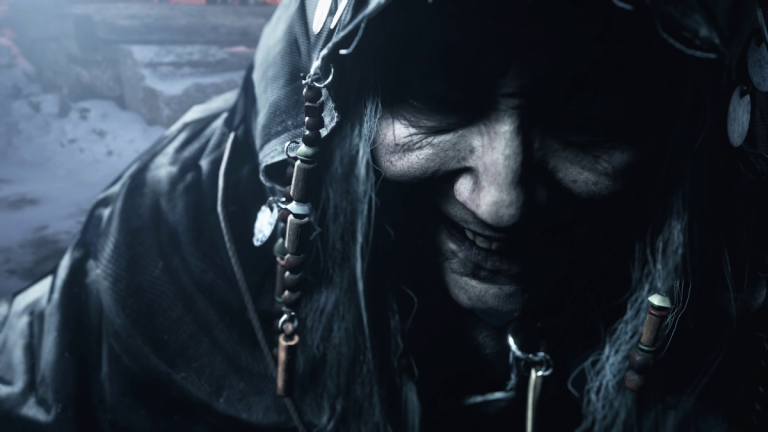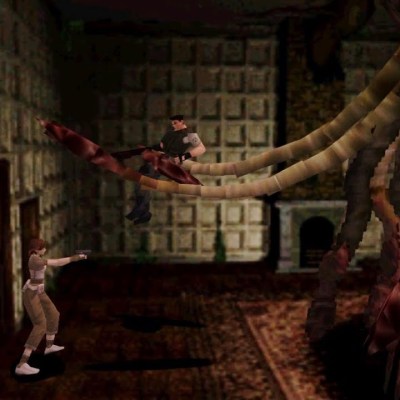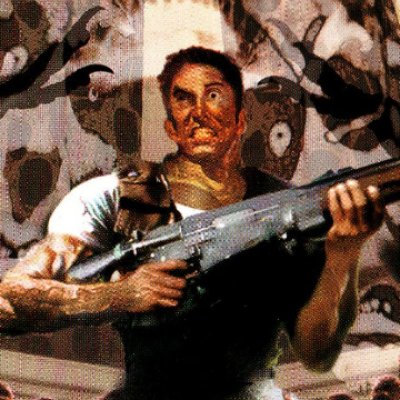Resident Evil Village Struggles to Turn Horror Gaming into a Blockbuster
Should Resident Evil Village's success make you optimistic or worried about the future of Triple-A horror games?

In case you haven’t heard, Resident Evil Village is a hit. The game’s sales figures suggest it could go on to become the best-selling RE title ever, and critics and fans everywhere are ready to name Resident Evil Village one of the best games of 2021, one of the better Resident Evil games, and even one of the best demonstrations of next-gen gaming technology so far.
If you’re looking at Resident Evil Village as a product, it’s hard not to consider the game a success even this early into its lifespan. Capcom is probably pretty happy with the game, and in many of the ways that matter most, they should be happy. Resident Evil Village is a very good game. You could even probably throw out the word “great” in many circles and not have to argue about it.
It’s when you start to ask questions about how Resident Evil Village works as a “horror” game, though, that the conversation surrounding arguably the biggest release of 2021 so far becomes much more complicated.
Resident Evil Village is a Gameplay Theme Park With a “Horror Land” Section
Coming out of Resident Evil 7, I hoped that its eventual sequel would end up being more like the first 3/4 of the game (which emphasized small sets, limited resources, and often unnerving moments of horror) and less like the last 1/4 of the game (which relied a bit too much on an awkward form of first-person gunplay). Given that the millions of people who played Resident Evil 7 also praised those early parts of the game and were critical of its later sections for roughly those same reasons, there seemed to be a popular belief the next game in the series would advance what worked and address what didn’t.
There’s a degree to which that proved to be true, but one of the most surprising things about Resident Evil Village is how it’s structured. Whereas the previous game’s thematic divide felt like a questionable decision, the divide here is significantly more deliberate. It’s almost like the game is an amusement park divided into four themed “lands” that are connected by a hub area where you get your refreshments and souvenirs.
Two of those lands (Lady Dimitrescu’s castle and Donna Beneviento’s home) are not only clear examples of horror game design but very good examples at that. Hell, Lady Dimitrescu’s castle is practically a throwback to most of RE‘s “trademark” elements (large stalker characters who chase you throughout the area, limited resources, puzzles, and a creepy residential setting). It’s not just a reminder of so many of the things we fell in love with about this franchise over the years but it’s the section of the game that most clearly resembles what many people considered to be the best parts of Resident Evil 7 and the ideas that made them fall in love with the series again.
Donna Beneviento’s home is arguably even more interesting than that. It deprives you of all your weapons and items and makes you solve what turns out to essentially be an elaborate escape room. The designs of its hallways and rare use of “fetus horror” make it a clear callback to P.T., but it feels more like a bigger nod to games like Outlast and Amnesia which emphasized a “defenseless” style of horror at a time when Triple-A horror games were still often relying on more action-based gameplay.
You can’t be talked into liking these sections of the game if you just don’t like them, but as someone who looked forward to the idea of Village expanding on RE 7‘s best horror ideas, these two areas gave me pretty much exactly what I was looking for and more. Dimitrescu’s castle was an engaging bit of survival horror that combined ’90s tropes with modern sensibilities while Beneviento’s house was a genuinely terrifying piece of game design that felt like the team flexing their ability to go toe-to-toe with the most legendary designers in modern horror gaming. These two areas prove that when the Resident Evil team wants to make a great horror game that would be top of its class in any era of horror gaming, they are more than capable of doing so.
So does Resident Evil Village stop trying to scare you beyond those initial sections? Not exactly, but the way that the game divides its campaign into these clearly defined gameplay areas starts to become more pronounced as it abandons more traditional horror ideas in favor of something…different
Resident Evil Village’s Action Sequences Often Struggle to be Scary
It’s tempting to say Resident Evil Village‘s third and fourth main areas (which are ruled over by Salvatore Moreau and Karl Heisenberg) abandon horror in favor of action, but that’s not strictly true. Moreau is an intimidating presence whose fish form forces you to stay on the move, and Heisenberg’s factory is filled with creative monstrosities who often overwhelm you in tight corridors. It’s not like the game suddenly becomes Max Payne.
The problem isn’t that these sections aren’t trying to be scary. The problem is that they struggle to take the best horror elements of the previous sections and incorporate them into the action.
Moreau’s section is often intense, but it’s not very threatening. Moreau’s scripted movements and the relatively linear nature of this area mean that it lacks the constant threat of Dimitrescu’s presence or the overwhelming feeling of dread that looms over Beneviento’s mansion. It’s not quite a scripted QTE section, but it often feels like one in the worst ways.
Heisenberg’s lair is even stranger. At this point, Resident Evil Village just throws waves of werewolves at you and spices things up with battles against mechanical creations. It’s certainly not bad, but the bigger problem here is that you’re likely going to be armed to the teeth at this point in the game and probably not hurting for ammo as the previous two areas were light on enemy encounters. You even pilot a homemade tank in the final battle against Heisenberg! The entire area reminds me of the recent Wolfenstein games. That’s not necessarily a bad thing, but as the conclusion to what came before, it feels like less of a pay-off that builds off your mechanical and emotional investments and more of a detour.
Even though the popular line on Resident Evil Village is that it’s more action-heavy than the previous game, the real thing that stands out is how jarring so much of the action of the later sections is in comparison to the rest of the game. When the game does crank up the action, it does so in such a way that feels almost hostile towards the ideas of “survival horror” and resource management. Because of that, the scares it does throw at you are almost all overcome by a few bullets. The less said about the game’s boss fights (which take the idea of bullet sponges to a frustrating new level), the better.
Resident Evil Village isn’t quite four games in one, but the awkward transition between its main areas can leave you with the feeling you’re dining on a sampler rather than just ordering the one thing you really want.
Village tries to unify these ideas in various ways, but the results are a mixed bag. For instance, I mostly love the game’s use of a “merchant,” but you really only start to feel his value at higher difficulty levels when enemies require more bullets to kill. Otherwise, he’s a save room companion that appears often enough to ensure you rarely feel resource-starved.
I also wanted to love his upgrade system (which requires you to turn in animal meat for permanent boosts and abilities) but the heavily scripted placement and behavior of the game’s animals mean that it rarely felt satisfying to find and kill them, while the easy nature of the game’s combat meant I rarely felt incentivized to go out of my way for help. It’s another example of a good idea that just isn’t incorporated well into the overall experience and ends up standing out in a negative way.
The same is true of the actual village’s “Metroidvania” like design, which gives the impression that it’s filled with unlockable shortcuts and secrets but ultimately proves to be surprisingly linear. Most shortcuts you find are found through the course of natural progression, and only a couple of treasures require you to go out of your way. There again, though, your desire to go out of the way for any of it may be hindered by the game’s generally forgiving nature, which already makes these sometimes disconnected ideas feel even more arbitrary.
It’s tempting to say that the game’s developers didn’t know what kind of game they wanted to make so they just threw a little bit of everything in there, but that’s likely not the case. In fact, I do think that Village‘s team knew exactly what kind of game they wanted to make. It’s just that the game they wanted to make seemingly wasn’t united by the idea of horror but rather a fear over what has happened to horror games of the past.
Resident Evil Village Reminds Us Horror Games Are Rarely Best Sellers
A 2019 report on the best-selling survival horror games in U.S. history reveals that seven of the top-ten titles are from the Resident Evil franchise and that the top two sellers (Resident Evil 4 and 5) are the ones that utilized more action-heavy design ideas.
The non-Resident Evil games on that list (The Evil Within, Dead Space 2, and Dying Light) may also come as a surprise. Where are beloved and acclaimed horror games like Silent Hill, Amnesia, and Until Dawn? They’re much further down the list than you probably want to hear.
Horror games have traditionally struggled to become blockbuster hits, which is quite surprising when you consider that horror movies have consistently been some of the film industry’s most profitable products. If there’s a difference between the two, it seems that many more people have fun being scared with friends while watching a horror movie than they do when playing video games (often, in the case of horror, by themselves). Indeed, the interactive nature of video games makes them one of the most effective mediums for horror.
When it comes to Resident Evil Village, that seems to have been the “problem.” In a recent interview, Village producer Tsuyoshi Kanda said that the team took it as a “compliment” some players found Resident Evil 7 too scary but noted that “it’s always our goal to create something that anybody can feel comfortable jumping in and playing, so we eased up on the tension curve [in RE Village] relative to Resident Evil 7: Biohazard, so players aren’t in constant fear.”
So as it turns out, the Village team’s apparent decision to not bind all these ideas they had with the thread of scaring the hell out of us at all times was apparently very much intentional. Resident Evil Village isn’t trying to be the scariest game you’ve ever played and failing at doing so; it’s trying to be a horror game that gets more people into horror games.
There’s a degree to which I respect that approach more than I can put into words. I love horror, and I want as many people as possible to love horror. I wouldn’t show someone who’s not a horror fan the scariest movie I can think of to get them into the genre, and I wouldn’t tell someone who is scared of horror games to get over it and play Alien: Isolation. I’d tell them to start on a classic like Bride of Frankenstein, and I’d sooner recommend they play something like Resident Evil Village and be thrilled if they ended up enjoying a game that was still as scary as this one sometimes is.
If Resident Evil Village‘s strong sales inspire more studios to make horror games, then I’ll consider it a success in a way that goes beyond any criticisms I could possibly throw at some of its design decisions. We need more great horror games, and if they happen to look as good as Village and be embraced as widely as this game has been so far, so much the better. I don’t need Resident Evil Village to be the scariest horror game ever, but I would love it if its success allowed some other studio to go out and make that very game.
In many ways, then, Resident Evil Village is a horror blockbuster. Yet, the ways it’s not quite worthy of that title make me worry about the immediate future of the franchise and perhaps the genre.
Resident Evil Village Doesn’t Make it Clear Where Resident Evil Goes From Here
If Resident Evil 7 was about 75% horror and 25% action, I’d say that Village is closer to 50/50. As noted above, though, the bigger talking point is how the game struggles to fold horror into the more action-focused sections and instead makes the dividing line between them a bit bolder than ever.
The dream scenario is that Capcom finds a way to keep that 50/50 style but finds a way to blend those ideas together smoothly enough that you don’t notice the lines that separate them. At the very least, we can hope that Resident Evil 9 doesn’t make its later parts quite so action-heavy and frontload the horror rather than spreading it evenly throughout. It certainly seems counterproductive to suggest that you’re making a game less scary to reach a wider audience but then putting nearly all of your best scares at the front of the game when you’re more likely to dissuade them from continuing or even starting.
Yet, it’s hard not to wonder if the next Resident Evil game will continue the series’ recent evolution by making the horror portion of the experience just a bit smaller. It’s a decision that may not matter much if there were enough notable horror games on the market to pick and choose your preferences, but at a time when it seems Resident Evil is one of the last Triple-A horror survivors, it almost feels like the series is burdened with the task of finding how to make a better horror blockbuster rather than continuing to suggest that “horror games” and “blockbuster games” are forever destined to be two different design concepts and that the latter will continue to eat the former if necessary.


